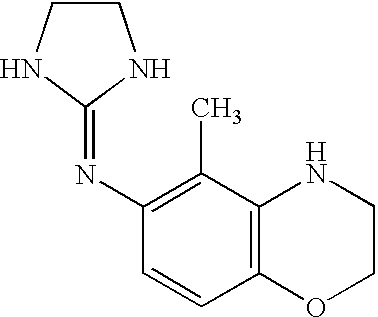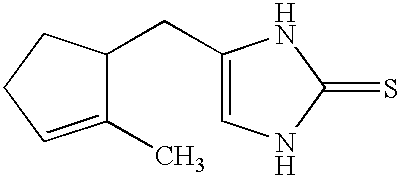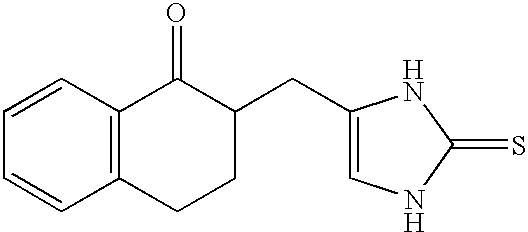Novel methods and compositions for alleviating pain
a composition and pain technology, applied in the field of pain relief, can solve the problems of limited tolerance, cognitive changes, nausea, and current therapies have serious side effects such as sedation, nausea, and pain
- Summary
- Abstract
- Description
- Claims
- Application Information
AI Technical Summary
Benefits of technology
Problems solved by technology
Method used
Image
Examples
example ii
Peripheral Treatment of Pain in .alpha.2-A Receptor Knock-Out MICE USING .alpha.-ADRENERGIC AGONISTS
[0118] This example demonstrates that .alpha.-adrenergic agonists are effective analgesic agents when administered peripherally in the absence of .alpha.-2A receptor activation.
[0119] A. Peripherally Administered .alpha.-Adrenergic Agonists are Effective Analgesic Agents in .alpha.-2A Knockout Mice
[0120] Non-specific .alpha.-adrenergic agonists were assayed in .alpha.-2A receptor deficient ("knockout") mice (Hein et al., supra, 1999) using a mouse model of sulprostone sensitized pain in which allodynia is evoked by intrathecal administration of a selective prostaglandin E2 receptor agonist to conscious mice essentially as described in Minami et al., Pain 57:217-223 (1994). In this model, the pain response to stroking the flank with a paint brush is scored eight times over a 35 minute period starting 15 minutes following spinal administration of sulprostone and intrathecal or intraperi...
example iii
Relief of Pain by Peripheral Administration of .alpha.-Adrenergic Agonists in Genetically Unaltered Animals
[0129] This example demonstrates that .alpha.-adrenergic agonists can be peripherally administered to produce a significant analgesic effect with less than a 20% reduction in motor or muscular activity in animals having wild type .alpha.-adrenergic receptors.
[0130] A. Selective .alpha.-2A Antagonists can be Used in Combination With Peripherally Administered .alpha.-Adrenergic Agonists to Produce Analgesia
[0131] The Chung rat nerve ligation model is a well accepted model of peripheral neuropathic pain. In the Chung model, partial ligation of left spinal nerves L-5 and L-6 produces a long-lasting hypersensitivity to light touch on the affected left foot. The hypersensitivity is similar to pain experienced by humans with the neuropathic condition of causalgia (Kim and Chung, Pain 50:355-363 (1992)).
[0132] When administered by intrathecal injection to Chung rats, the pan-.alpha.-2 ...
example iv
Long-Term Relief of Chronic Pain
[0143] This example demonstrates that .alpha.-adrenergic agonists with minimal .alpha.-2A activity can mediate a long-term reversal of the chronic pain phenotype.
[0144] A. Long-term Pain Relief in Chung Model Rats
[0145] Structurally distinct .alpha.-adrenergic agonists were assayed for the ability to produce prolonged relief of chronic pain in Chung model rats following extended dosing. In particular, Chung model animals were dosed for seven days using a subcutaneous osmotic minipump with vehicle control or 0.1 mg / kg / hour of the following .alpha.-adrenergic agonist with minimal .alpha.-2-A activity: Compound 8, Compound 9, Compound 3 or Compound 4. Pain relief was observed during the period of drug treatment; for example, Compound 8 alleviated the allodynia 90-100%, and Compound 9 alleviated the allodynia 60-80%, as shown in FIG. 5A. Notably, the analgesic effects of these compounds as well as Compound 3 and Compound 4 continued for over a month after...
PUM
| Property | Measurement | Unit |
|---|---|---|
| time | aaaaa | aaaaa |
| volume | aaaaa | aaaaa |
| pain threshold | aaaaa | aaaaa |
Abstract
Description
Claims
Application Information
 Login to View More
Login to View More - R&D
- Intellectual Property
- Life Sciences
- Materials
- Tech Scout
- Unparalleled Data Quality
- Higher Quality Content
- 60% Fewer Hallucinations
Browse by: Latest US Patents, China's latest patents, Technical Efficacy Thesaurus, Application Domain, Technology Topic, Popular Technical Reports.
© 2025 PatSnap. All rights reserved.Legal|Privacy policy|Modern Slavery Act Transparency Statement|Sitemap|About US| Contact US: help@patsnap.com



